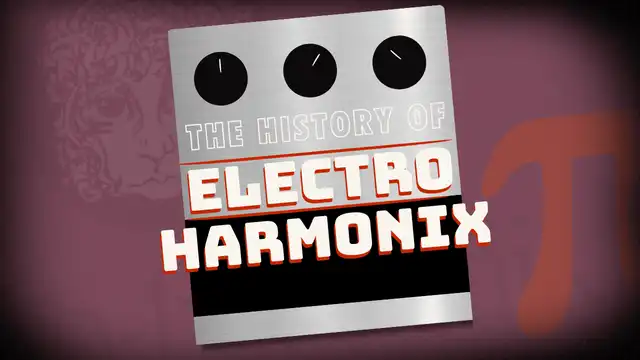The History of Electro-Harmonix


Even though some major guitar heroes of the 1960s utilized early stompboxes, very few companies turned their attention to effects and pedal-pickings remained slim for a long time. However, a small handful of forward-thinking gear enthusiasts and entrepreneurs understood the power of pedals, and with the help of some influential guitarists, managed to push stompboxes into the mainstream. Mike Matthews’ Electro-Harmonix (EHX) was one of these pioneering manufacturers. Driven by ingenuity and a love of fuzz, EHX changed the course of gear evolution, and in doing so, music itself. Let’s take a look at Electro-Harmonix history and the pedals that put this legacy company on the map.

B.E.H. (Before Electro-Harmonix)
The origins of Electro-Harmonix history really traces the story of one man - Mike Matthews. Matthews was a music enthusiast who played keys as a kid and went on to work as a promoter in his college years. Music became a smaller part of his life when he got a day job at IBM, but he still moonlit booking shows, even crossing paths with some legends the likes of Chuck Berry and Jimi Hendrix.
In 1967, The Rolling Stones’ mega-hit “Satisfaction” featured a sound that popular audiences had not heard before - the Maestro Fuzz-Tone. Employed by Keith Richards, the Fuzz-Tone produced a raw distortion that listeners loved, and once they took off in the market Maestro couldn’t build them fast enough.
This is where Mike Matthews’ confluent interests in engineering and music changed fuzz history. Bill Berko, a guitar repairman, reached out to Matthews to see if he’d be interested in producing fuzz pedals to help meet the newfound demand generated by the Fuzz-Tone. Matthews agreed in the hopes he’d be able to make enough money to leave his job at IBM and focus entirely on his musical interests.
Berko ended up being very little help at all, but Matthews persisted in designing a fuzz pedal akin to the Fuzz-Tone. His model had tons of attack and distortion and was noticed by Al Dronge, founder of Guild Guitars. Dronge understood the demand for these new devices and offered to buy Matthews’ pedals in bulk - marketing them as The Guild Foxey Lady thanks to Hendrix’s popularity. While the Foxey Lady is a pre-EHX invention, its success changed Matthews’ life, Electro-Harmonix history, and the world of guitar gear forever.
Electro-Harmonix is Born
At 26 years old and starting with $1,000 in his pocket, Mike Matthews founded his own company, calling it Electro-Harmonix. The very first pedal designed from scratch under the EHX banner was the LPB-1 Linear Power Booster, a boost designed to push amps into overdrive. Matthews also continued making and selling his fuzz pedals, calling EHX’s version the Axis Fuzz (not to be confused with Roger Mayer’s Axis Fuzz) whilst Guild continued to sell them under the Foxey Lady name.
Matthews struck gold in 1969 with the release of the Big Muff Pi, the fuzz that defined the EHX sound and cemented the brand’s popularity. This pedal blew up, selling well and becoming the fuzz of choice for the likes of Jimi Hendrix, and David Gilmour.
Electro-Harmonix history pushed forward into the 1970s with numerous additions to their lineup that are still in use today - The Small Stone, Small Clone, Electric Mistress, and Deluxe Memory Man are just a few that now reside in the pantheon of iconic pedals.
With today’s saturated market, it’s easy to take for granted just how revolutionary these pedals and the sounds they were used to create were at the time of their introduction. Matthews’ vision pushed boundaries and defined many of the effects that continue to be emulated almost 60 years later.
Electro-Harmonix History in Four Pedals
Before we carry on into modern Electro-Harmonix history, let's take a closer look at four of the pedals that put EHX on the map.
Big Muff
The Big Muff is the first pedal that most players think of in association with Electro-Harmonix. This now-ubiquitous pedal was one of the first commercial fuzzes on the market, has remained in production for nearly six decades, and is often the first pedal a guitarist will try and/or buy.
Big Muffs come in many different varieties, ranging from the Ram’s Head and Op-Amp to the Pi and Russian. Like any good fuzz pedal, each model has its own idiosyncrasies, but they all point back to the original circuit that Matthews introduced in 1969. Known for tones ranging from creamy sustain to crushing distortion, Muffs simply produce an epic fuzz tone that can be heard on some of the biggest records of all time. Hendrix, Gilmour, Kurt Cobain, John Frusciante, Jack White, Thom Yorke, Dimebag Darrell, Billy Corgan, and many more have turned to the Big Muff. Smashing Pumpkins’ “Zero” is an excellent example of what the Big Muff can do.
Deluxe Memory Man
The Big Muff might be the pedal most closely associated with Electro-Harmonix, but the Memory Man is the #1 EHX pick of many connoisseurs. First introduced in the mid 70s, the Memory Man is an analog bucket brigade delay. Simply put, its job is to create delayed repeats of a guitar's output, ranging from punchy slapback to infinite, oozing oscillation. The Memory Man gave guitarists more flexibility and portability by combining delay and echo, with a circuit that could support delay times that were the longest of their day.
After the original Memory Man blew guitarists’ minds, EHX released the Deluxe Memory Man with additional features including Chorus and Vibrato. DMMs are some of the most sought after - and pricy - analog delays on the second-hand market.
Today EHX offers a few different Memory Mans including the Memory Man, Deluxe (Reissue), and Micro.
While analog delays are the forebears of extremely complex digital delay pedals, the Memory Man was revolutionary for its time. Some notable users include the Edge, Robert Smith, J. Mascis, Ed O’Brien. Robert Smith in particular made great use of the pedal for his atmospheric soundscapes.
POG
EHX’s Polyphonic Octave Generator - "POG", to its friends - comes more recently in Electro-Harmonix history. Released in the early aughts, it quickly became one of EHX’s most popular pedals, now available in numerous variants to satisfy all manners of pedalboard.
As its name suggests, the POG takes an input and creates additional layers of pitches above or below the source notes. These can be stacked with a guitar’s tone or the input can be dialed out entirely, giving players myriad options to make their 6 strings sound like 12-strings, organs, or entire orchestras with harmonic interplay produced by the plucking of a single note.
This pedal really ramped up in popularity after John Mayer used it for the organ sounds on “In Repair” off of Continuum. Since then it’s been used by the likes of Josh Homme, Johnny Greenwood, Joe Satriani, Billy Strings, and more.
Superego
Another modern EHX pedal, the Superego pushes into experimental territory by incorporating effects such as sampling, synthesis, and infinite sustain to open up a pathways to wild new soundscapes. Players can attack notes with freezes and glissandos that turn guitars into synth emulators.
The Superego is a bit more niche, but nevertheless it’s become an iconic pedal that has been used by artists like Mike Gordon, Troy Van Leeuwen, Johnny Marr, and more, giving it a special place in Electro-Harmonix history.
Sovtek and the Return of Mike Matthews
As with many other iconic brands, the salad days of the 70s led to financial hardships in the 1980s for Mike Matthews and Electro-Harmonix. After a union dispute in 1981, EHX filed for bankruptcy in ‘82, opening up a challenging period in which Matthews struggled to kickstart the company’s production.
Between EHX’s initial bankruptcy and 1988, Matthews sought success outside of pedals, founding a Russian-based tube manufacturer called the New Sensor Corporation. Within a few years, Matthews was leading the production of amps, pedals, and vacuum tubes under the Sovtek name.
With the success of Sovtek, Matthews was able to pivot back to EHX, which got its production back underway in New York in the early 90s and has remained one of the most successful pedal companies on the planet ever since.

Mike Matthews and Electro-Harmonix
Mike Matthews saw a need in the market and was inspired to make guitar pedals, but it was his ear and sense of innovation that made Electro-Harmonix one of the most popular pedal companies of all time. For any company to maintain profitability for nearly 60 years is a tremendous feat, and in the niche market of effects, EHX’s long-term success is analogous to that of a brand like Fender or Gibson. More than business success, Matthews’ creations helped to define the tonal palette of multiple generations of musicians.
Any rig starts with a player, a guitar, and a great set of strings. If you want to experience Electro-Harmonix history, throw a Big Muff into the mix, crank it up, and get lost in the fuzz that changed the world.
Other Posts you may like

Guitar Strings Order: How the Guitar is Tuned and Why

Two Handed Tapping: Our Top 8 Tappers of All Time

Which Guitar Strings Wear Your Fret Wire Down More?

What is Nashville Tuning? Its History, Best Guitar Strings & Uses

Guitar Scale Length Explained: String Tension & Playability

What Guitar Strings I Used To Play...
0 Responses
Leave a Reply
Your email address will not be published. Required fields are marked *

